gm9s80 installation manual

This manual provides essential guidelines for installing the Goodman GM9S80 gas furnace, ensuring safety, efficiency, and compliance with industry standards. Proper installation by a qualified technician is critical to avoid hazards and ensure optimal performance. Always follow safety precautions and refer to this manual for detailed instructions.
1.1. Importance of Proper Installation
Proper installation of the Goodman GM9S80 gas furnace is critical to ensure safe, efficient, and reliable operation. Incorrect installation can lead to hazards such as gas leaks, electrical issues, or reduced performance. Adhering to the manual’s guidelines helps prevent potential risks, ensuring compliance with safety standards and regulations. A well-installed furnace optimizes energy efficiency, reduces operational costs, and extends the unit’s lifespan. Always follow the instructions carefully to avoid damage, property loss, or personal injury. Proper installation also ensures warranty validity and maintains the furnace’s performance ratings, providing consistent and safe heating for years to come.
1.2. Safety Precautions and Warnings
The Goodman GM9S80 installation requires strict adherence to safety precautions to prevent hazards. Improper installation can lead to gas leaks, electrical shocks, or fires. Always shut off gas and electrical supplies before starting work. Ensure proper ventilation to avoid carbon monoxide buildup. Only qualified, trained personnel should perform installations, adjustments, or repairs. Failure to follow safety guidelines may result in personal injury, property damage, or equipment malfunction. Refer to the manual for specific warnings and precautions to ensure a safe and correct installation process. Ignoring these precautions can void the warranty and lead to serious consequences, including legal and financial liabilities.
1.3. Essential Components of the Manual
This manual is divided into sections to guide installers through the GM9S80 furnace installation process. It includes technical specifications, safety precautions, and step-by-step installation instructions. The manual also covers post-installation checks, maintenance tips, and troubleshooting common issues. Detailed diagrams and charts provide visual guidance for complex procedures. Compliance with local regulations and industry standards is emphasized throughout. By following the manual, installers can ensure the furnace operates efficiently and safely, meeting both performance and safety expectations. Proper adherence to the manual’s guidelines is crucial for warranty validation and optimal system functionality over time.
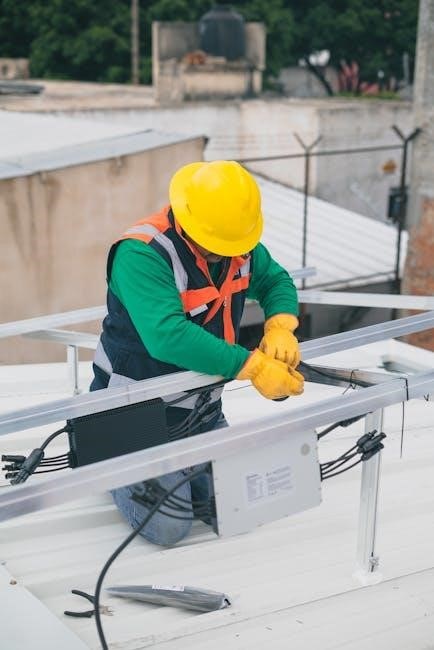
Pre-Installation Requirements
Ensure proper location assessment, necessary clearances, and venting requirements are met. Verify gas line sizing and electrical connections comply with local codes and manufacturer specifications for safe operation;
2.1. Location Considerations
Proper location is critical for safe and efficient operation of the Goodman GM9S80 gas furnace. Ensure the unit is installed in a well-ventilated area, away from flammable materials; Compliance with local building codes and ANSI Z21.47/CSA-2.3 standards is mandatory. The furnace must be positioned to allow adequate clearances for maintenance and repair. Avoid installing in areas exposed to excessive moisture or corrosive substances. Ensure the location provides easy access for service personnel. Proper drainage and leveling are essential to prevent operational issues. Always follow the manufacturer’s guidelines for installation in specific environmental conditions. Local regulations and utility requirements must also be adhered to for a safe and compliant setup.
2.2. Necessary Clearances and Venting Requirements
Proper clearances and venting are essential for safe and efficient operation of the Goodman GM9S80 gas furnace. Maintain minimum clearances of 24 inches from combustible materials and ensure adequate space for maintenance access. Venting must comply with local codes and manufacturer guidelines, using approved materials like PVC or ABS. The venting system should have a minimum diameter of 2 inches for horizontal runs and 3 inches for vertical runs. Ensure proper slope and termination to prevent condensate buildup and blockages. Follow the manual’s specifications for vent termination to avoid combustion issues. Proper venting ensures safe removal of flue gases and optimal furnace performance. Always adhere to local regulations and safety standards.
2.3. Gas and Electrical Connections
Proper gas and electrical connections are critical for safe and efficient operation of the Goodman GM9S80 gas furnace. The gas line must be sized correctly to ensure adequate flow, using approved materials like black iron or corrugated stainless steel. Install a drip leg to trap moisture and debris before the gas valve. Electrical connections must comply with the National Electrical Code, using properly sized wires and fuses. Ensure all connections are secure to prevent loose wires, which could cause electrical hazards. Refer to the manual for specific wiring diagrams and voltage requirements. Proper connections ensure reliable operation, safety, and compliance with local regulations. Always test connections for leaks and integrity before finalizing the installation.
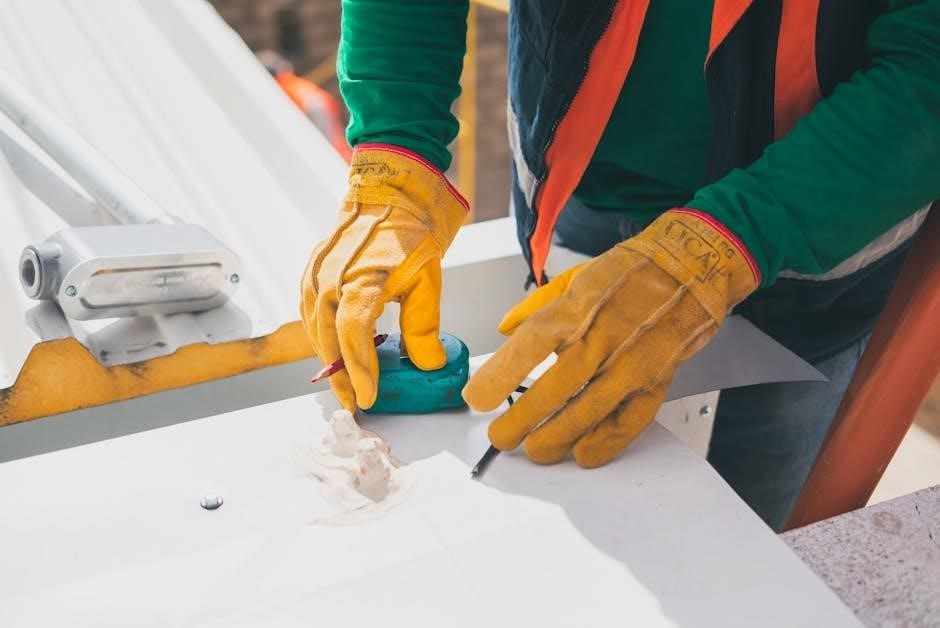
2.4. Environmental and Regulatory Compliance
The Goodman GM9S80 gas furnace must be installed in accordance with local, state, and federal environmental and safety regulations. Ensure compliance with standards like ANSI Z21.47/CSA 2.3 for gas-fired central furnaces. Verify that the installation meets Ultra Low NOx emissions requirements if applicable. Proper venting and clearances are essential to minimize environmental impact and ensure safe operation. Familiarize yourself with regional building codes and permits required for installation. The furnace must only be installed in areas designated by regulatory authorities. Failure to comply may result in legal consequences or operational hazards. Always adhere to environmental guidelines to promote sustainable and safe heating solutions. Regulatory compliance ensures both safety and efficiency in furnace operation.

Installation Process
The installation involves site preparation, furnace placement, and connecting electrical, gas, and venting systems. Follow the manual closely to ensure proper setup and functionality of the GM9S80 furnace.
3.1. Site Preparation and Furnace Placement
Proper site preparation and furnace placement are critical for safe and efficient operation. Ensure the installation location meets all clearance requirements, avoiding areas prone to water damage or extreme temperatures. The furnace must be placed on a level, stable surface and securely anchored to prevent movement. Verify the unit is positioned correctly for its intended configuration (upflow or downflow). Check for proper alignment with ductwork and venting systems. Install a drip leg on the gas line to trap moisture and debris. Use flexible connections to reduce noise transmission. Always follow local building codes and manufacturer guidelines for placement and installation. Refer to the manual for specific airflow requirements.
3.2. Unpacking and Inspecting the Furnace

Handle the furnace with care to avoid damage during unloading and unpacking. Inspect the unit for any signs of shipping damage, such as dents, scratches, or loose components. Verify that all necessary parts, including the burner, heat exchanger, and control board, are included and undamaged. Check for any manufacturing defects or issues that may require immediate attention. Ensure the gas valve, igniter, and electrical connections are intact and functioning properly. Refer to the packing list to confirm all accessories are present. If any damage or missing items are found, contact the supplier before proceeding with installation. Proper inspection ensures a safe and efficient setup;
3.3. Electrical Connections and Wiring
Ensure all electrical connections are made according to the National Electrical Code and the furnace’s specifications. Verify the voltage and wiring match the unit’s requirements. Connect the power supply to the furnace’s control board, ensuring proper grounding for safety. Install fuses or circuit breakers as specified to protect against overcurrent. Secure all wires tightly to prevent loose connections, which could cause malfunctions. Refer to the wiring diagram in the manual for correct terminal connections. Test the electrical system after installation to ensure proper operation and safety. Always use properly sized wires and follow local electrical regulations to avoid hazards such as overheating or electrical fires. Proper wiring is essential for efficient and safe furnace operation.
3.4. Venting System Installation
Proper venting is critical for safe and efficient furnace operation. Use approved venting materials, such as PVC or stainless steel, to ensure durability and compliance with local codes. The venting system must be airtight to prevent gas leaks and maintain proper draft. Follow the manufacturer’s guidelines for vent pipe sizing and configuration. Ensure the venting system is correctly aligned with the furnace’s venting ports to avoid obstructions. Verify that all connections are secure and sealed to prevent combustion byproducts from escaping. Always test the venting system after installation to ensure proper function and compliance with safety standards. Proper venting installation is essential for optimal performance and safety.
3.5. Gas Line Installation and Testing
Install the gas line according to local codes and regulations, ensuring it is properly sized for the furnace’s input rating. Use approved materials, such as copper or PVC, and ensure all connections are securely tightened. Avoid any leaks by applying a suitable sealant to threaded connections. After installation, perform a gas leak test using a soap solution or electronic detector to verify system integrity. Pressurize the line and check for bubbles or alarms, which indicate leaks. If no leaks are detected, the system is ready for operation. Always follow safety protocols when handling gas lines to prevent accidents. Proper installation ensures safe and efficient furnace operation.
3.6. Final Positioning and Alignment
Ensure the furnace is placed on a level surface and secured firmly to prevent movement. Align the unit to maintain proper airflow and ventilation, adhering to the manufacturer’s guidelines. Verify that all connections, including electrical, gas, and venting lines, are securely attached and undamaged. Double-check the alignment of the venting system to ensure correct airflow and compliance with safety standards. Make sure the furnace is positioned to meet the required clearances from walls and other objects. Finalize the installation by ensuring all components are properly aligned and the system is ready for safe operation, as outlined in the Goodman GM9S80 installation manual.
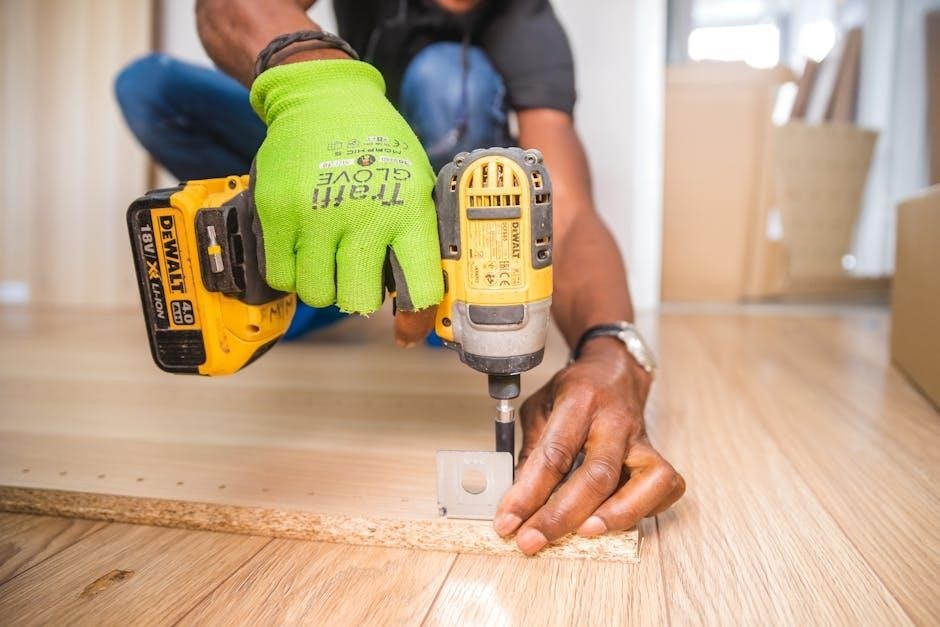
Post-Installation Checks
Ensure the furnace operates safely and efficiently by verifying all connections, testing system performance, and checking for leaks or electrical issues. Adhere to the manual’s guidelines.
4.1. Testing the Furnace Operation
After installation, test the furnace operation to ensure proper functionality. Start by setting the thermostat to “heat” and monitor the system’s startup sequence. Verify that the burners ignite consistently and the blower operates smoothly. Check for unusual noises or vibrations. Ensure all electrical connections are secure and functioning correctly. Test the furnace’s ability to maintain the desired temperature and monitor for any error codes on the control board. Perform a complete cycle test to confirm reliable operation. Refer to the manual for specific testing procedures and troubleshooting steps if issues arise. Proper testing ensures safety, efficiency, and optimal performance of the GM9S80 furnace.
4.2. Leak Detection and Gas Line Safety
After installing the gas line, perform a thorough leak detection test to ensure system safety. Use a soap solution to inspect all connections for bubbles, which indicate leaks. Turn off the main gas valve if a leak is detected and tighten or replace faulty connections. Ensure the gas line is properly sized and meets local regulations. Regularly inspect the drip leg for debris and moisture to prevent blockages. Always follow the manufacturer’s instructions for testing procedures. Proper gas line installation and maintenance are critical to prevent hazards, ensuring safe and efficient furnace operation. Adhere to all safety guidelines to avoid potential risks associated with gas leaks.
4.3. Verification of Electrical Connections
Verify all electrical connections to ensure they are secure and meet the furnace’s specifications. Check the voltage and wiring against the National Electrical Code and the furnace’s requirements. Ensure the circuit breaker or fuse box is correctly sized and configured. Refer to the manual for specific wiring diagrams and electrical ratings. Test the control board and sensors for proper functionality. Inspect all connections for tightness and signs of wear. Use a multimeter to confirm voltage levels at the furnace’s electrical terminals. Ensure grounding is properly established to prevent electrical hazards. If unsure, consult a licensed electrician to verify the setup. Proper electrical connections are vital for safe and efficient furnace operation.
4.4. Ensuring Proper Ventilation
Proper ventilation is critical for safe and efficient furnace operation. Ensure the venting system is installed according to the manual’s specifications, using approved materials and configurations. Verify that vent pipes are correctly sized, securely connected, and properly sloped to prevent condensate buildup. Check for any blockages or leaks in the venting system, as these can lead to carbon monoxide hazards. Ensure the vent termination is clear of obstructions and meets local building codes. Test the ventilation system for proper airflow and pressure. Regularly inspect and maintain the venting system to ensure optimal performance and safety. Proper ventilation ensures efficient heating and prevents potential safety risks.
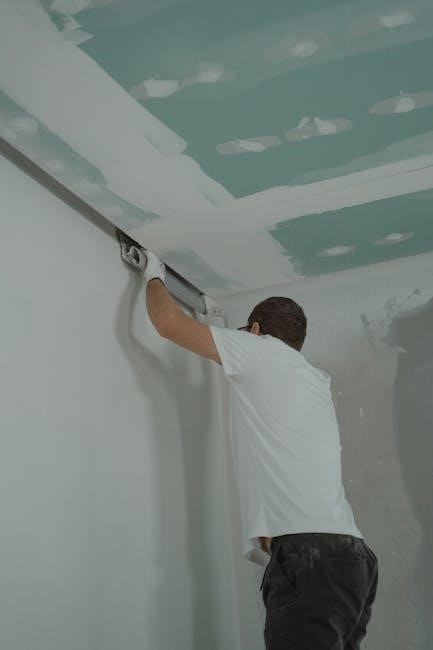
Maintenance and Troubleshooting
Regular maintenance ensures optimal performance and longevity. Inspect filters, clean components, and check for leaks. Troubleshoot common issues like ignition failures or sensor malfunctions using diagnostic tools provided in the control board. Address errors promptly to prevent system downtime. Schedule annual professional servicing to maintain efficiency and safety. Always refer to the manual for specific troubleshooting guidance and maintenance schedules.
5.1. Regular Maintenance Tasks
Regular maintenance is crucial for optimal performance and longevity of the Goodman GM9S80 furnace. Clean or replace air filters monthly to ensure proper airflow. Inspect the heat exchanger annually for signs of damage or corrosion. Check venting systems for blockages or leaks to maintain safe operation. Ensure all gas connections are secure and free from leaks. Clean the blower compartment and motor to prevent noise and inefficiency. Verify that drain lines are clear to avoid water damage. Schedule annual professional servicing to inspect ignition systems, burners, and safety controls. Refer to the manual for detailed maintenance schedules and procedures to ensure compliance with manufacturer recommendations.
5.2. Troubleshooting Common Issues
Troubleshooting the Goodman GM9S80 furnace involves identifying common issues and addressing them promptly. If the furnace fails to ignite, check the gas supply, ignition system, and ensure the valve is open. For intermittent operation, inspect the thermostat settings and electrical connections. If the furnace is producing loud noises, clean the blower and motor, and ensure proper venting. Address error codes by referring to the diagnostic chart in the manual. Low airflow issues may require cleaning or replacing the filter and checking for blockages in ducts. Always turn off power before servicing and consult a professional if issues persist. Regular maintenance can prevent many of these problems.
5.3. Resetting the Furnace and Error Codes
To reset the Goodman GM9S80 furnace, turn off the power at the circuit breaker, wait 30 seconds, and restore power. This often resolves minor issues. Error codes displayed on the seven-segment LED provide diagnostic information. For example, a flashing “1” indicates an ignition failure, while “2” signals a pressure switch issue. Refer to the manual for a complete list of codes and their meanings. If an error persists after resetting, check the corresponding system (e.g., gas valve, venting, or electrical connections). If issues remain unresolved, consult a qualified technician. Regular maintenance and prompt error resolution ensure safe and efficient furnace operation.
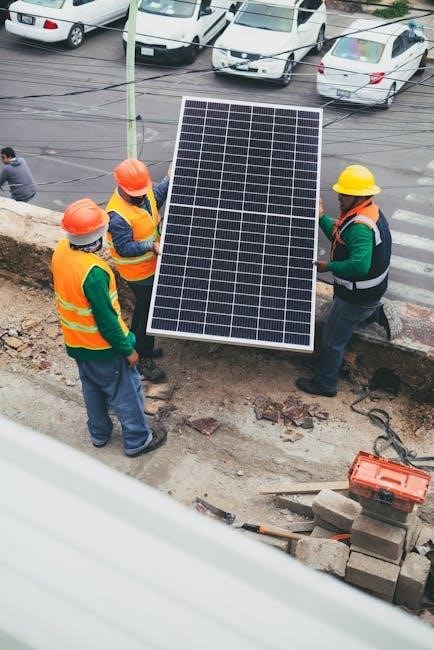
Safety Precautions
Always turn off the power supply before starting any installation or maintenance. Ensure proper ventilation to prevent carbon monoxide buildup. Follow all safety codes and manufacturer guidelines to avoid potential hazards and ensure safe furnace operation.
6.1. General Safety Guidelines
Always prioritize safety during the installation and operation of the Goodman GM9S80 gas furnace. Ensure the power supply is turned off before starting any work. Wear appropriate protective gear, including gloves and safety glasses, to prevent injuries. Proper ventilation is crucial to avoid carbon monoxide buildup. Follow all local and national safety codes, as well as the manufacturer’s instructions, to minimize risks. Never attempt any installation or repair without proper training or tools. Keep the area clean and clear of flammable materials. Regularly inspect the system for leaks or damage. Adhere to these guidelines to ensure safe and efficient furnace operation.
6.2. Electrical Safety Measures
Ensure all electrical connections are made in accordance with the National Electrical Code and local regulations. Verify that the furnace’s electrical rating matches the supply voltage to prevent damage or fire hazards. Use properly sized fuses and wires, and avoid overheating by ensuring connections are secure and tight. Always disconnect the power supply before performing any maintenance or repairs. Ground the furnace correctly to prevent electrical shocks. Keep all electrical components away from water and moisture. Never use damaged or frayed cords, and ensure all circuits are rated for the furnace’s power requirements. Adhere to these measures to maintain electrical safety and system integrity.
6.3. Gas Safety and Leak Prevention
Ensure the gas line is properly installed and tested for leaks using a gas detector or soap solution. Install a drip leg to trap dirt and moisture before the gas valve. Always turn off the main gas supply when servicing or repairing the furnace. Use approved materials for gas line connections to prevent leaks and corrosion. Regularly inspect all gas fittings and connections for signs of wear or damage. Proper ventilation is essential to prevent gas buildup. Follow local regulations and industry standards for gas line installations. Use isolation valves to shut off gas supply during maintenance. Address any leaks immediately to avoid hazards.
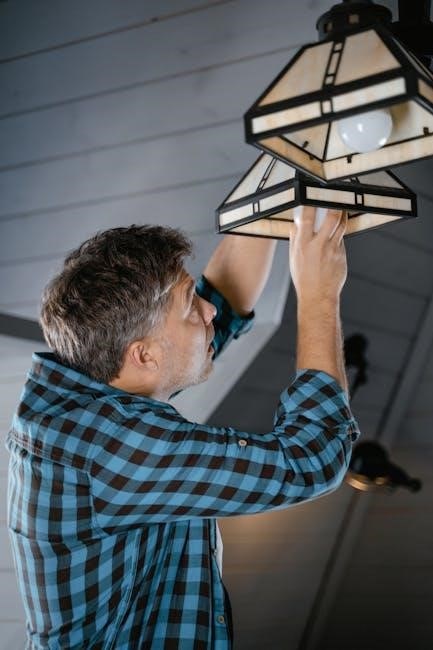
Technical Specifications
The Goodman GM9S80 is a single-stage, multi-speed ECM gas furnace with an 80% AFUE rating; It features a heavy-duty aluminized-steel heat exchanger and stainless-steel secondary exchanger for efficient heat transfer. Designed for multi-position installation, it includes a single-stage gas valve and durable Silicon Nitride igniter. The furnace operates quietly and provides consistent heating performance.
7.1. Furnace Dimensions and Weight
The Goodman GM9S80 gas furnace features dimensions designed for versatile installation, with a depth of 21 inches and height of 34 inches, making it suitable for various spaces. The unit weighs approximately 135 pounds, ensuring stability and ease of placement. Constructed with a heavy-gauge steel cabinet, it provides durability and resistance to environmental factors. The furnace’s compact design allows for efficient installation in both upflow and horizontal configurations, accommodating different HVAC system requirements. These dimensions ensure proper fitment while maintaining optimal performance and airflow capabilities.
7.2. Performance Ratings and Capacities
The Goodman GM9S80 gas furnace delivers reliable performance with an 80% AFUE rating, ensuring efficient heating while minimizing energy consumption. It features a single-stage gas valve and a multi-speed ECM blower, providing consistent and quiet operation. The furnace offers a heating input capacity of 80,000 BTU/h and an output of 64,000 BTU/h, making it suitable for a variety of heating needs. Designed for versatility, it supports both upflow and downflow configurations, adapting to different installation requirements. The unit’s performance is optimized for durability and efficiency, meeting industry standards for safety and reliability, and is compliant with ANSI Z21.47 specifications;
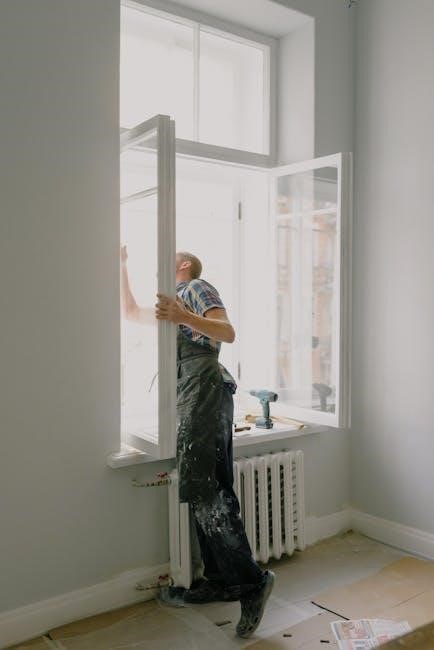
Warranty and Service Information
The Goodman GM9S80 furnace is backed by a comprehensive warranty, ensuring coverage for parts and labor under specified conditions. Regular maintenance by certified technicians is required to uphold warranty validity and ensure optimal performance, as outlined in the service guidelines provided in this manual.
8.1. Warranty Terms and Conditions
The Goodman GM9S80 furnace is covered by a limited warranty that protects against defects in materials and workmanship. The warranty period varies depending on the component, with the heat exchanger typically covered for a longer duration. To maintain warranty validity, the furnace must be installed, operated, and maintained in accordance with the instructions provided in this manual. Improper installation or failure to adhere to maintenance guidelines may void the warranty. Additionally, only authorized service technicians should perform repairs or adjustments to ensure compliance with warranty terms. Regular maintenance is essential to uphold coverage and ensure optimal performance. Always refer to the warranty section in this manual for full details and conditions.
8.2. Service and Repair Guidelines
Only authorized and trained service technicians should perform repairs or maintenance on the Goodman GM9S80 furnace. Always refer to the official service manual for specific instructions and safety protocols. Before servicing, ensure the power and gas supply are turned off to avoid potential hazards. Use genuine Goodman replacement parts to maintain product integrity and warranty validity. The furnace features a self-diagnosing control board that displays error codes to assist in identifying issues. Regular maintenance, such as cleaning filters and inspecting venting systems, is crucial for optimal performance. Any repairs must comply with local regulations and safety standards to ensure reliability and efficiency. Always follow the manufacturer’s guidelines for troubleshooting and part replacement.
Adhering to the guidelines in this manual ensures safe and efficient installation of the Goodman GM9S80 furnace. Always follow safety protocols and maintain regular upkeep for optimal performance.
9.1. Summary of Key Installation Steps
Proper installation of the Goodman GM9S80 furnace involves several critical steps. First, ensure the site is prepared, and the furnace is placed correctly. Next, unpack and inspect the unit for damage. Proceed with electrical connections, ensuring compliance with local codes. Install the venting system according to specifications to ensure safe operation. Connect and test the gas line to prevent leaks. Finally, position and align the furnace properly, and perform thorough post-installation checks. Always follow the manual’s guidelines and safety precautions to ensure efficient and safe operation. Proper training and adherence to these steps are essential for a successful installation.
9.2. Final Safety Reminders
Always adhere to safety guidelines when installing and operating the Goodman GM9S80 furnace. Ensure all connections meet local codes and standards. Only trained professionals should perform installations or repairs. Regularly inspect the system for leaks, proper venting, and electrical integrity. Keep the area around the furnace clear of flammable materials. Test the gas line for leaks after installation and ensure the venting system functions correctly. Familiarize yourself with emergency shutdown procedures. Never operate the furnace if you suspect a malfunction. Always follow the manufacturer’s instructions and safety precautions to ensure safe and efficient operation. Proper maintenance and adherence to these guidelines are crucial for long-term safety and performance.



Leave a Reply
You must be logged in to post a comment.